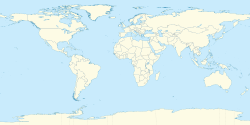You can help expand this article with text translated from the corresponding article in Korean. (June 2012)Click [show] for important translation instructions.
|
Naro Space Center Korean: 나로우주센터 | |
|---|---|
 | |
| Summary | |
| Airport type | Spaceport |
| Owner | Government of South Korea |
| Operator | KARI |
| Location | Outer Naro Island, Goheung, South Jeolla, South Korea |
| Opened | June 11, 2009 |
| Time zone | Korea Standard Time (+09:00) |
| Coordinates | 34°25′55″N127°32′06″E / 34.43194°N 127.53500°E |
| Website | www |
| Map | |
| Naro Space Center | |
| Hangul | 나로우주센터 |
|---|---|
| Hanja | 羅老宇宙센터 |
| RR | Naro uju senteo |
| MR | Naro uju sent'ŏ |
The Naro Space Center is a South Korean spaceport in South Jeolla's Goheung County, operated by the state-run Korea Aerospace Research Institute.
Contents
- History
- Naro-1
- KSLV-II TLV
- Nuri
- Facilities
- LC-1 (LB-1)
- LC-2 (LB-2)
- See also
- References
- External links
The spaceport is located about 485 km (300 mi) south of Seoul. [1] It includes two launch pads, a control tower, rocket assembly and test facilities, facilities for satellite control testing and assembly, a media center, an electric power station, a space experience hall and a landing field. [2] [3] It has supported 5 launches including the KSLV-II launch in 2021, and will support SSLV launches in 2025.







